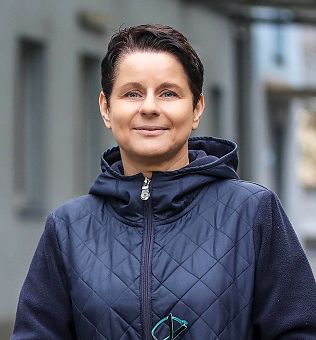News
Article
Hepatitis B Markers, Reactivation Do Not Impact Effectiveness of DAA Therapy for HCV
Author(s):
Response to direct-acting antiviral therapy was similar between patients with and without HBV coinfection, with most patients completing the planned course of treatment and achieving SVR, even in the case of HBV reactivation.
Dorota Zarębska-Michaluk
Credit: Termedia

A real-world population study is detailing the prevalence of hepatitis B virus (HBV) serologic markers in patients with hepatitis C virus (HCV) and the risk of HBV reactivation during treatment with direct-acting antiviral (DAA) therapy.
Among more than 1000 patients with chronic HCV, 0.7% were positive for hepatitis B virus surface antigen (HBsAg) and 14.3% had evidence of a past HBV infection – neither the presence of HBV markers nor the occurrence of reactivation reduced the effectiveness of DAA therapy.1
“While a chronic HBV infection is not entirely curable at present, despite available treatment suppressing viral replication and lowering the risk of cirrhosis and hepatocellular carcinoma, HCV infections can be successfully and safely treated with direct-acting antiviral agents. Therefore, it is pivotal to establish whether HCV treatment with DAA can lead to HBV reactivation in coinfected individuals,” wrote investigators.1
HCV and HBV coinfection is not uncommon due to the shared modes of transmission between the viruses, although the exact number of patients impacted is unknown and may be underestimated due to reduced HBV levels in the presence of hepatitis C. Severe liver disease and a greater risk of progression to liver cancer are primary concerns of HBV/HCV coinfection. This highlights the need for effective treatment, something that remains challenging for clinicians and requires further investigation.2
Dorota Zarębska-Michaluk, associate professor in the department of infectious diseases at Jan Kochanowski University in Poland, and colleagues sought to examine the characteristics of coinfected patients undergoing HCV treatment with DAAs, their risk of HBV reactivation, and the effectiveness of the treatment. To do so, they retrospectively obtained patient data from medical records for consecutive patients with chronic HCV infection receiving antiviral treatment with interferon (IFN)-free regimens from July 1, 2015, to December 31, 2022, at a single hepatology center.1
Data on HCV genotype, baseline viral load measured by polymerase chain reaction (PCR) with a lower limit of detection 10 IU/ml, extrahepatic manifestations, history of previous antiviral therapy, and current DAA regimen were collected, including genotype‑specific and pan-genotypic options. Investigators additionally gathered data on the course of the therapy, adverse events, and deaths during treatment and up to 12 weeks after its completion.1
In total, 1118 patients with chronic HCV infection were enrolled in the study and tested for HBV coinfection by determining HBsAg and anti-HBc antibodies. Investigators divided participants into 3 subgroups based on their HBV status: HBsAg- and anti‑HBc‑negative (n = 950; 85%; group A), HBsAg‑negative and anti‑HBc‑positive (n = 160; 14.3%; group B), and 8 individuals positive for HBsAg (0.7%; group C).1
HBsAg- and anti‑HBc‑positive patients were monitored for HBV reactivation during DAA treatment and up to 24 weeks after its completion, with investigators defining reactivation as a ≥ 100‑fold increase in HBV DNA concentration in individuals with previously detectable HBV DNA or HBsAg or HBV DNA detection in individuals with previously undetectable anti‑HBc antibodies.1
Patients in groups B (81.3%) and C (87.5%) had more comorbidities than those in group A without HBV coinfection (77.7%). Investigators noted biochemical markers were comparable between the groups but pointed out group C had the highest percentage of patients with F4 fibrosis (37.5%) and the lowest percentage of treatment‑naive patients (62.5%) whereas group A had the most treatment‑naive patients (82%).1
Coinfected participants tended to be younger, with the youngest median age observed in group C (36 years; Interquartile range [IQR], 30.5-43 years). Among the HBsAg‑positive patients, genotype 3 type infections were significantly more common (37.5%) than in other groups.1
Despite these differences, investigators pointed out response to DAA therapy was comparable between the groups and most patients completed the course of treatment as planned, regardless of their HBV status. Sustained virologic response (SVR) was calculated as 98.4% in group A, 98.7% in group B, and 100% in group C.1
Investigators called attention to 3 cases of HBV reactivation, all of which were clinically silent and diagnosed based on laboratory findings – 2 of these cases were women on immunosuppressants with antihepatitis B core‑positive antibodies, and the third patient was an HBsAg‑positive man. Of note, all 3 cases achieved SVR after DAA therapy.1
“Our study provides important insights into the clinical characteristics of coinfected patients, the risk of HBV reactivation during DAA treatment of HCV infection, and the effectiveness of antiviral therapy. It also encourages further studies conducted in other populations, ultimately enabling to shape future recommendations and guidelines on HBV/HCV coinfection management,” investigators concluded.1
References:
- Zarębska-Michaluk D, Brzdęk M, Rzymski P, Dobrowolska K, Flisiak R. Hepatitis B virus coinfection in patients treated for chronic hepatitis C: Clinical characteristics, risk of reactivation with long-term follow-up and effectiveness of antiviral therapy. Pol Arch Intern Med. Published online January 2, 2024. doi:10.20452/pamw.16638
- Hepatitis B Foundation. Hepatitis C Coinfection. What is Hepatitis B? Accessed January 10, 2023. https://www.hepb.org/what-is-hepatitis-b/hepatitis-c-co-infection/





